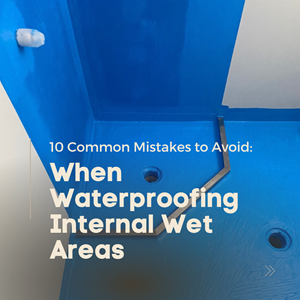Mitigating Risk: Waterproofing Strategies for Protecting Data Centre Equipment
Data centres are at the core of modern industries, supporting critical tasks ranging from artificial intelligence processing to cloud storage and even government operations. They house sensitive equipment that powers vital systems, making their uninterrupted operation a top priority. However, data centres face significant challenges from water-related risks, especially in Australia. Extreme weather events and rising sea levels present mounting concerns for the safety and integrity of these facilities, alongside the growing unpredictability of climate patterns.
Water ingress into a data centre can result in catastrophic outcomes, including hardware damage, loss of data, and costly downtime. According to industry reports, the average cost of a data centre outage can range between $700,000 and $1 million, depending on the severity. These figures underscore the importance of robust waterproofing strategies in protecting both the infrastructure and the immense value they hold. This blog explores the challenges faced by data centres in Australia, details the importance of waterproofing, and provides actionable strategies to mitigate risk.

Why Waterproofing Matters for Data Centres
Data centres operate in tightly controlled environments with specific temperature, humidity, and electrical requirements. Even a small amount of water ingress can disrupt these systems, leading to severe consequences. For instance, a single leak can cause short circuits, damage servers, or corrode critical components. Beyond physical damage, the consequences often extend to prolonged downtime, loss of customer trust, and reputational harm.
Australia's unique environmental context exacerbates these risks. The country's susceptibility to natural hazards such as cyclones, flash flooding, and heavy rainfall highlights the need for proactive waterproofing strategies. Additionally, urban areas may experience localised flooding due to overburdened drainage systems, particularly as infrastructure ages and populations grow. For coastal regions in Australia, rising sea levels and storm surges further increase vulnerabilities.
Given these challenges, advanced waterproofing measures are no longer optional; they are essential. A thorough approach ensures not only the protection of valuable equipment but also the resilience of data centres to withstand Australia’s unpredictable climate.
Comprehensive Strategies for Data Centre Waterproofing
A multi-layered waterproofing plan can significantly reduce the risks posed by water ingress. The strategies below provide a more detailed overview of best practices for data centres globally and, more specifically, in Australia.
1. Location Selection and Site Planning
Site selection serves as the foundation of a waterproofing strategy. While this decision is usually made during the early stages of development, its impact creates lasting effects.
- Assess Flood Risks: Choose a site with minimal exposure to flooding. Geographic information systems (GIS) can assess flood maps and historical weather patterns to inform this decision. For example, inland sites on higher ground may be preferable over areas prone to riverine or coastal flooding.
- Climate Change Considerations: Long-term planning must take climate projections into account. Rising sea levels, more intense storms, and increased precipitation should factor heavily into site assessments for Australian data centres.
2. Elevated Structures and Sloping Designs
For areas with unavoidable flood risk, structural modifications can elevate resiliency.
- Foundation Elevation: Constructing data centres on elevated platforms or piers reduces the possibility of water reaching critical systems. This technique is crucial in coastal and low-lying regions of Australia, such as Queensland.
- Sloping and Drainage: Use sloped landscaping designs to direct water away from the facility. Concrete barriers or levees may also assist in preventing localised flooding caused by heavy rainfall.
3. Drainage Systems and Routine Maintenance
Robust drainage systems provide a line of defence against water accumulation. However, even the most advanced systems require upkeep.
- Advanced Drainage Solutions: Install high-capacity stormwater drainage systems equipped with grates and debris filters. These systems should be designed to handle volumes exceeding historical rainfall averages, preparing for unexpected weather patterns.
- Regular Inspections: Conduct routine maintenance of all drainage facilities, including clearing blockages, inspecting infrastructure for wear, and testing overflow systems.
4. Sump Pumps and Backup Solutions
Sump pumps act as an emergency measure to remove water that has already entered a building's lower levels.
- Dual-Pump Systems: Equip data centres with primary and secondary sump pumps. The secondary pump functions as a failsafe in case the first malfunctions or lacks capacity.
- Battery Backup: Include battery-powered or generator-supported sump pumps to ensure functionality during power outages. This measure is critical, as many flooding events coincide with electrical disruptions

5. Leak Detection and Early Warning Systems
Advanced technologies allow teams to identify and mitigate leaks before they escalate into major issues.
- Sensor Deployment: Install moisture sensors underneath equipment racks, around entry points, and near vulnerable plumbing systems. These sensors can trigger automated alarms and deliver real-time feedback to maintenance teams.
- Integrated Monitoring: Pair leak detection tools with centralised monitoring software. This integration allows on-site staff and remote teams to respond quickly, minimising potential damage.
6. Humidity and Ventilation Management
Waterproofing efforts should also focus on controlling indoor humidity, as high moisture levels can lead to condensation damage.
- Dehumidifiers: Deploy industrial-grade dehumidifiers in conjunction with HVAC systems to maintain consistent humidity levels.
- Airflow Design: Position ventilation fans and ducts strategically to maximise air circulation. Proper airflow reduces the likelihood of moisture buildup in confined spaces.
7. Sealing and Insulation
Strong building envelope protection plays a critical role in waterproofing.
- Sealing Vulnerabilities: Use high-grade sealants around all openings, including windows, doors, and vents. Pay close attention to cable entry points, which are often overlooked despite being a common pathway for water ingress.
- Insulated Panels and Membranes: Apply waterproof membranes and insulated cladding to exterior surfaces. These layers ensure that even heavy rainfall or prolonged exposure to moisture won’t compromise the structure.
8. Power Backup and Redundancy
Unforeseen events often disable primary power systems, leaving data centres vulnerable. Resilient facilities include robust backup measures.
- Uninterruptible Power Supplies (UPS): Equip infrastructure with UPS systems to ensure uninterrupted power to critical equipment.
- Generator Placement: Ensure that diesel or gas-powered generators are housed in elevated, watertight enclosures. Test generators regularly to confirm they can withstand flood events.
9. Routine Audits and Continuous Improvement
Waterproofing is not a one-time effort but an ongoing process.
- Periodic Inspections: Conduct regular audits of the building envelope, drainage systems, and waterproofing layers to identify vulnerabilities before disaster strikes.
- Staff Training: Train facility teams in emergency response protocols related to water ingress and the use of waterproofing systems

Building Resilience for the Future
Waterproofing plays a pivotal role in ensuring the safety, reliability, and operational continuity of data centres. By investing in comprehensive waterproofing strategies, operators can mitigate risks and enhance resilience against Australia’s increasingly volatile weather conditions. From robust drainage systems to advanced leak detection technologies, these measures not only protect valuable investments but also secure the seamless operation of businesses worldwide.
Are you seeking tailored solutions for protecting your data centre from water-related risks? Download our Data Centre Brochure or reach out to our Specifications and Technical Teams for expert advice. Together, we can build facilities that weather any storm.
 Waterproofing
10 Common Mistakes to Avoid When Waterproofing Internal Wet Areas
Waterproofing
10 Common Mistakes to Avoid When Waterproofing Internal Wet Areas
 Waterproofing
Waterproofing Wisdom: Do’s and Don’ts For A Dry & Durable Structure
Waterproofing
Waterproofing Wisdom: Do’s and Don’ts For A Dry & Durable Structure
